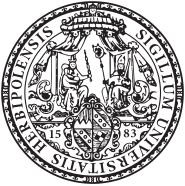University of Wuerzburg
| Julius-Maximilians-Universität Würzburg | |

Seal of the Julius Maximilians University Wurzburg
|
|
| Latin: Universitas Julius-Maximilianae Herbipoli | |
| Motto | Cosmopolitan, innovative, tradition of excellence |
|---|---|
| Type | Public |
| Established | 1402 (closed 1415—1582) |
| Chancellor | Uwe Klug |
| President | Alfred Forchel[] |
| Undergraduates | 29,911 (term 2016/17) |
| Location | Würzburg, Germany |
| Campus | Urban |
| Colours | Blue and White |
| Affiliations |
U15 Coimbra Group |
| Website | www |
 |
|
The Julius Maximilian University of Würzburg (also referred to as the University of Würzburg, in German Julius-Maximilians-Universität Würzburg) is a public research university in Würzburg, Germany. The University of Wurzburg is one of the oldest institutions of higher learning in Germany, having been founded in 1402. The University initially had a brief run and was closed in 1415. It was reopened in 1582 on the initiative of Julius Echter von Mespelbrunn. Today, the University is named for Julius Echter von Mespelbrunn and Maximilian Joseph.
The University of Würzburg is part of the U15 group of research-intensive German universities. The university is also a member of the Coimbra Group.
Its official name is Julius-Maximilians-Universität Würzburg (or "Julius-Maximilian University of Würzburg") but it is commonly referred to as the University of Würzburg. This name is taken from Julius Echter von Mespelbrunn, Prince-Bishop of Würzburg, who reestablished the university in 1582, and Prince Elector Maximilian Joseph, the prince under whom secularization occurred at the start of the 19th century. The University’s central administration, foreign student office, and several research institutes are located within the area of the old town, while the new liberal arts campus, with its modern library, overlooks the city from the east. The university today enrolls approximately 29,000 students, out of which more than 1,000 come from other countries.
Although the university was first founded in 1402, it was short-lived. This was attributed to the lack of financial security and the instability of the age. Johannes Trithemius, well-known humanist and learned abbot of the Scottish monastery of St. Jacob, held the then dissolute student lifestyle responsible for the premature decline of the city's first university. In the Annales Hirsaugiensis Chronologia Mystica of 1506 he cites bathing, love, brawling, gambling, inebriation, squabbling, and general pandemonium as "greatly impeding the academic achievement in Würzburg". Evidence of this is provided by the fatal stabbing of the university's first chancellor, Johann Zantfurt, in 1413, by a scholar's unruly assistant, or famulus, evidently the result of these very influences. Despite Egloffstein's thwarted first attempt at founding a university, the city still boasts one of the oldest universities in the German-speaking world, almost on a par with Prague (1348), Vienna (1365), Heidelberg (1386), Cologne (1388), and Erfurt (1392).
...
Wikipedia
